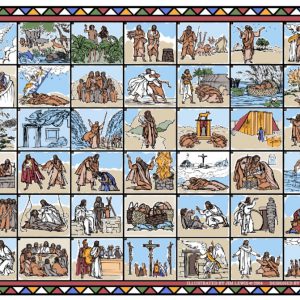
Early Years of Discovery
Very early in our ministry experiences among oral learners in the villages of Mexico, we often asked some “analytical, expository” questions about the Scripture passages we were introducing. In our ignorance about oral tradition and learning styles, our questions were directed at abstract nuances of meaning, at implied inferences and broader applications. The questions would hang heavy in the air, unanswered; our dialogue attempts met with awkward silence. But one day while watching the Jesus film, we were struck by the simplicity of Jesus’ questions. Even when speaking to a lawyer or a religious leader, His questions were rhetorical, direct, simple, and very easy to answer.
Jesus the Master Communicator
From then on, our dialogue in the villages changed. We began to pattern our questions after the dialogue style of Jesus Himself. He already was our inspiration for using the mother tongue and for using parables. Jesus used Aramaic, the mother tongue of his audience, so they would understand. Likewise, He chose parables to provide contextualized illustrations.
He also knew the common people admired the repetitious speech of the Hebrew poets and prophets and used such speech in His teachings, such as the Beatitudes. Since Jesus was a master at understanding His audience, why would He not be the inspiration for our style of dialogue? Should we not also avoid abstract, theoretical questions?
We noticed that the simpler Jesus’ questions, the more profound the truth that lay within. “Who do people say that I am? Who do you say that I am?” Profound and essential truth lay within the answers to those two questions. In the telling of the parable of the Good Samaritan, the dialogue began with a question from a lawyer who was trying to justify himself. “Who is my neighbor,” he asked. Jesus then told the well-known story and ended by asking, “Who then was his neighbor?” The obvious answer was given, the command to action stated. The meaning was stunningly clear, especially within a culture that understood the natural enmity with Samaritans. Jesus’ questions were to the point, not speculative. We realized that by following Jesus’ model, we too could avoid ambiguous and intangible concepts so inappropriate among oral learners.
Relevancy and WHY Questions
In learning more about the dialogue style of Jesus, we recognized that intuitively, Jesus seemed to stay away from WHY questions. In Luke 17:17-18, Jesus performed a miracle, healing ten lepers. He asked:
“Were not ten cleansed? Where are the nine?” Notice Jesus did not ask WHY the nine went away without a word of thanks. Instead Jesus said, “Was no one found to return and give praise to God except this foreigner?”
Another of Jesus’ questions in Matthew 7:4 avoided the word WHY in a rather spectacular way:
“Or how can you say to your brother, ‘let me take out the speck in your eye’ when you yourself do not see the log in your own eye?” The question says it all.
Jesus’ simple, direct questions and answers were part of His whole approach to communication, RELEVANCY. He understood His audience, and He asked concrete questions pertaining to people, events, actions, and locations in everyday life. In understanding His audience, He always got to the heart of the matter—what was relevant in His listeners’ lives and would bring them closer to the Kingdom of God.
Jesus’ Discovery Style
Jesus modeled His own kind of discovery learning. Listeners were required to observe, participate, answer questions, and take action. Jesus sometimes responded to questions with a story, followed by questions of His own. He encouraged two-way conversation, giving specific, contextualized examples. His characters themselves provided the truth, illustrating the right or wrong path.
His metaphors were inspired by everyday symbols and illustrations. The answers to His questions were always supplied in His story or parable. His questions were not “beyond” the story but were content-oriented. He did not ask the listeners to leap to conclusions, infer, project feelings, thoughts, or emotions that were not there. He never said, “What did you learn from the parable?” Instead he directed them to the truth within the story and then challenged them to action, to go and apply what they had learned. Jesus simply stated,
“Go and do the same.” “Go and show the priests.” “Go and tell others.” “Go and sin no more.”
What do you think about Jesus’ dialogue and discovery style? Please share your thoughts or additional learning about these insights and observations. If you have a moment, we would really like to hear from you!
By Jim and Carla Bowman, founders of Scriptures In Use
« Fula Stories Spread Rapidly Orality Missiology: The Relationship Factor »










